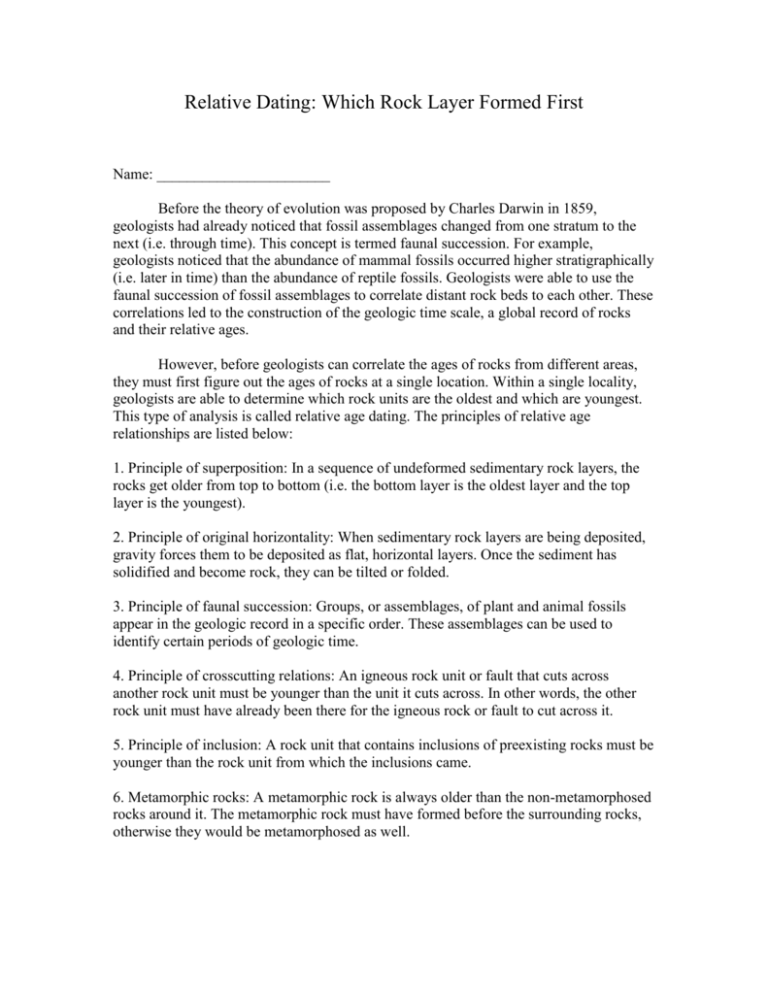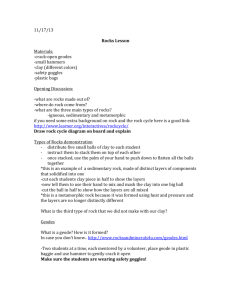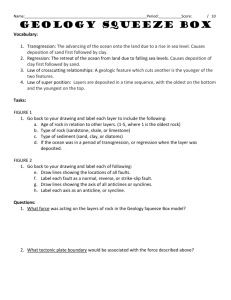Relative Dating Worksheet
advertisement

Relative Dating: Which Rock Layer Formed First Name: _______________________ Before the theory of evolution was proposed by Charles Darwin in 1859, geologists had already noticed that fossil assemblages changed from one stratum to the next (i.e. through time). This concept is termed faunal succession. For example, geologists noticed that the abundance of mammal fossils occurred higher stratigraphically (i.e. later in time) than the abundance of reptile fossils. Geologists were able to use the faunal succession of fossil assemblages to correlate distant rock beds to each other. These correlations led to the construction of the geologic time scale, a global record of rocks and their relative ages. However, before geologists can correlate the ages of rocks from different areas, they must first figure out the ages of rocks at a single location. Within a single locality, geologists are able to determine which rock units are the oldest and which are youngest. This type of analysis is called relative age dating. The principles of relative age relationships are listed below: 1. Principle of superposition: In a sequence of undeformed sedimentary rock layers, the rocks get older from top to bottom (i.e. the bottom layer is the oldest layer and the top layer is the youngest). 2. Principle of original horizontality: When sedimentary rock layers are being deposited, gravity forces them to be deposited as flat, horizontal layers. Once the sediment has solidified and become rock, they can be tilted or folded. 3. Principle of faunal succession: Groups, or assemblages, of plant and animal fossils appear in the geologic record in a specific order. These assemblages can be used to identify certain periods of geologic time. 4. Principle of crosscutting relations: An igneous rock unit or fault that cuts across another rock unit must be younger than the unit it cuts across. In other words, the other rock unit must have already been there for the igneous rock or fault to cut across it. 5. Principle of inclusion: A rock unit that contains inclusions of preexisting rocks must be younger than the rock unit from which the inclusions came. 6. Metamorphic rocks: A metamorphic rock is always older than the non-metamorphosed rocks around it. The metamorphic rock must have formed before the surrounding rocks, otherwise they would be metamorphosed as well. To better understand these principles, let’s make our own outcrop using clay provided by your teacher. 1. Flatten the green clay into a single layer. This layer represents a layer of sedimentary rocks. 2. Next, “deposit” another rock layer by flattening the red clay and stacking it on top of the green layer. 3. Do the same with the blue clay so that, from the side, the clay layers look like the pages of a book. 1. Which principle have we illustrated with these three layers? ________________________________________________________________________ ________________________________________________________________________ Now, bend the layers so that they slightly curve up, similar to the letter “U.” Remember, the clay represents sediments that have already solidified into rocks. What would happen if sediments were deposited onto those deformed rocks? To figure this out, imagine the following: The edges of clay layers extend further and flatten out Your entire clay stack is in a fish tank, so that the cross-sectioned side is up against the glass Now, pour sand onto the top layer of clay 2. After the sand fills up the basin (u-shaped part), will the surface of the sand be flat or curved? ________________________________________________________________ 3. Which principle is illustrated with this example? ________________________________________________________________________ ________________________________________________________________________ Now, let’s get back to your clay layers. Use your pencil to etch a straight, diagonal line across the edges of the layers. This etched line represents a fault cutting across our rock layers. A fault is a fracture in rock in which movement has occurred. 4. Which principle have we illustrated by etching the fault? ________________________________________________________________________ ________________________________________________________________________ 5. What would have happened to the fault if we drew the fault after making the three layers and then bended the layers (you can try doing this with your clay)? ________________________________________________________________________ ________________________________________________________________________ 6. Finally, draw the cross-section (side) view of your deformed and faulted clay layers: To apply the principles we just illustrated, geologists first make detailed sketches of rock outcrops similar to the one you just drew. Look at the following drawings and the symbol key, then use the relative age principles to determine the age relationships. Typically, geologists will list the age order of rocks from top to bottom, with the oldest rocks at the bottom and youngest at the top (like the principle of superposition). Note: You will notice that the top boundary of some of the rock layers is jagged. This boundary, an unconformity, is where the rock layer’s surface was exposed to wind and water erosion for a significant amount of time before the next sediments covered it. List the principles you used to determine the age relationships: _____________________ ________________________________________________________________________ List the principles you used to determine the age relationships: _____________________ ________________________________________________________________________ List the principles you used to determine the age relationships: _____________________ ________________________________________________________________________ The folding event occurred between the deposition of which two rock layers? ________________________________________________________________________ ________________________________________________________________________






